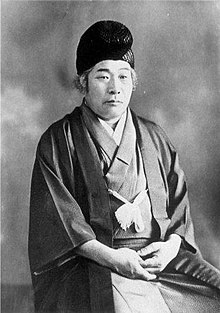Deguchi Onisaburō
Onisaburo Deguchi ( Jap. 出口王仁三郎 * 22. August 1871 in the village of Anao (Kuwada- gun , Tamba Province ); † 19th January 1948 ) was co-founder and influential figure of Oomoto , one of the new religious movements in Japan .
Born as Ueda Kisaburō ( 上 田 喜 三郎 ), the son of a farming family is said to have possessed extraordinary intellectual and spiritual abilities from a young age. In 1898 he met Deguchi Nao ( 出口 な お ), the founder of the Ōmoto religion. He joined the movement and quickly became one of its defining figures. In 1900 he married Nao's youngest daughter Sumiko (Sumi), who became the second spiritual leader of the Ōmoto religion after the death of her mother.
Under the influence of Deguchi Onisaburō, the new religion spread enormously in Japan and also made international contacts.
Deguchi wrote numerous writings, including the 81-volume work Reikai Monogatari ( 霊 界 物語 ). He was active in various artistic fields, making paintings, calligraphies and thousands of ceramics . One of the key messages of his teaching is the close connection between art and religion and the attempt to exert a positive influence on the world through artistic work.
In the West, Deguchi is best known for his formative influence on Ueshiba Morihei , the founder of the martial art Aikido , whom he met in 1919.
During the persecution of the Ōmoto religion by the Japanese state, he was imprisoned from 1935 to 1942.
Web links
- Inoue Nobutaka : "Deguchi Onisaburō" . In: Encyclopedia of Shinto. Kokugaku-in , April 4, 2006 (English)
- The Foundress and Successive Spiritual Leaders (Engl.)
| personal data | |
|---|---|
| SURNAME | Deguchi, Onisaburō |
| ALTERNATIVE NAMES | 出口 王仁 三郎 (Japanese); Wanisaburō; Ueda, Kisaburō (real name); 上 田 喜 三郎 (real name, Japanese) |
| BRIEF DESCRIPTION | Co-founder of the Ōmoto religion |
| DATE OF BIRTH | August 22, 1871 |
| PLACE OF BIRTH | Anao (Kuwada- gun , Tamba Province ) |
| DATE OF DEATH | January 19, 1948 |
